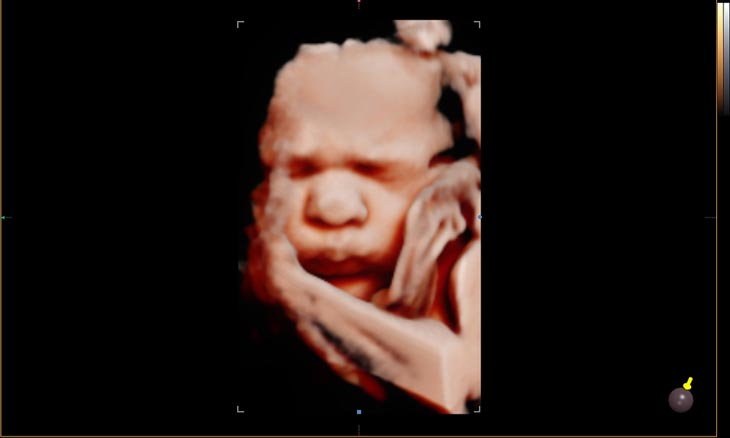If you are an expecting parent, then chances are you have to schedule a prenatal appointment sooner or later.
By performing a series of tests, the obstetrician will be able to tell if the mother and baby are in good health. One of these check-ups will include a 3D ultrasound, which provides a precious glimpse at how the developing fetus looks.
But for some people, looking at their child’s ultrasound image is confusing. Sometimes, the 3D ultrasound wide nose situation happens when the baby’s nose appears to be ridiculously large.
So, why is it the case? Should you be concerned about your kid’s health and appearance? All the answers will be addressed right below!
Why Does 3D Ultrasound Wide Nose Happen?

The baby’s nose looks weird on ultrasound because the nose is not supposed to look this way. Rather, it is a direct product of faulty sound waves.
To understand why a baby’s nose looks big on ultrasound, let’s examine how ultrasound works. When the viewing session begins, the ultrasound machine will emit sound waves. When these waves reach a surface and start bouncing off, they will send signals that allow the gadget to create an image.
If we are talking about smooth, flat surfaces, then a 3D ultrasound big nose will not be a thing. The problem is, when the waves travel through the womb and scan the child, they are confronted with tiny, crooked areas.
This is because the child has yet to reach its full human form. Since the waves cannot reflect back on these body parts, the ultrasound technology ends up expanding what it fails to see.
FAQs
1. Should I be worried that my baby’s face squished in ultrasound?
There is no need to fret over funny 3D ultrasound pictures. As explained above, the technology used in ultrasound is still very much in its early stages. Whatever unusual reflections you see on the screen can probably be traced back to the waves’ inability to capture accurate figures.
But to be sure, do not forget to consult with your doctors and see their professional opinions. Sometimes, what seems to be normal turns out to be abnormalities and defects.
2. Do all babies have a button nose?
Sometimes, you will spot how the baby’s nose looks flat on the ultrasound. Contrary to popular beliefs, these flat noses are the precise impressions of the noses in real life.
As developing fetuses lack the bridge of the nose, their noses do not have a bone to fall back on. As a result, the same pug nose can be seen on all newborn children.
3. Do babies’ noses change when they grow up?
Yes. In fact, most facial features of a kid tend to evolve as time goes by. The nose’s bridge will hold up higher and become bigger on both sides, giving kids larger nasal canals. The muscles start filling up, and the cartilage becomes sturdier.
Hence, be prepared to amaze at how different your kid’s nose ends up after they finish puberty, especially when compared to how it looks within the first few months.
4. Is it possible that baby with big nose on ultrasound needs an intervention?
In most cases, seeing a big nose on ultrasound is not a big deal. But admittedly, in some rare situations, this could point to nasal problems suffered by the fetus.
It might be the nasal skeleton that causes breathing problems, or the nose is strained inside the womb. The good thing is that most of these symptoms can be detected and treated fairly easily, so make sure to talk with your doctors and explore possible options.
5. Can I see if my baby has hair in 3D ultrasound?
Technically speaking, the hair’s surface is too tiny for the sound waves to bounce off and conceive a visible image. However, the waves are still able to identify the hair strands, resulting in several contours on the baby’s head.
If you happen to see the curves surrounding a child’s forehead and on the top of their head, it means that the baby has already grown some hair.
6. What is a 4D and 5D baby scan?
4D and 5D scans share an identical function as 3D scans, but they vary in terms of clarity, shadow tones, and resolution. While 3D photos only manage to offer parents a blurry look at their kid’s appearance, 4D and 5D scans are more realistic and highly authentic.
Obstetricians often utilize, thanks to their acute precision, 4D and 5D screenings to check out whether the baby has any anomalies. Unfortunately, 4D and 5D scans are still costly for the average household. Some areas do not even have access to 4D and 5D scanners.
Therefore, this option is not accessible for everyone.
Further watching: What is 4D ultrasound scan?
7. What is an HD ultrasound?
An economical yet effective alternative is the HD ultrasound if you cannot afford advanced 4D and 5D ultrasound viewings. Simply put, it takes advantage of 2D technology and turns the images into more genuine versions of otherwise fuzzy photos.
So how can you tell HD ultrasound from normal ultrasound? Easy enough! Look for the golden strips added to the scans instead of black and white only.
Conclusion
Having a 3D ultrasound wide nose is not a big medical issue, but many parents still find the whole experience unsettling. Rest assured that babies born with big noses should not be an alarm for mothers and fathers at this stage. All you have to worry about is the well-being of your child.
Please remember to forward this article to other expecting parents if you find the advice helpful and soothe their concerns!
